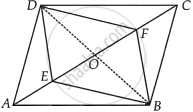Advertisements
Advertisements
Question
E and F are points on diagonal AC of a parallelogram ABCD such that AE = CF. Show that BFDE is a parallelogram.
Solution
Given: ABCD is a parallelogram and AE = CF
To show: OE = OF
Construction: Join BD, meet AC at point O.
Proof: Since, diagonals of a parallelogram bisect each other.

∴ OA = OC
And OD = OB
Now, OA = OC
And AE = CF ...[Given]
⇒ OA – AE = OC – CF
⇒ OE = OF
Thus, BFDE is a quadrilateral whose diagonals bisect each other.
Hence, BFDE is a parallelogram.
Hence proved.
APPEARS IN
RELATED QUESTIONS
Diagonals of a parallelogram `square`WXYZ intersect each other at point O. If ∠XYZ = 135° then what is the measure of ∠XWZ and ∠YZW?
If l(OY)= 5 cm then l(WY)= ?

The diagonals AC and BD of a parallelogram ABCD intersect each other at the point O. If ∠DAC = 32º and ∠AOB = 70º, then ∠DBC is equal to ______.
Diagonals of a parallelogram are perpendicular to each other. Is this statement true? Give reason for your answer.
In a parallelogram ABCD, AB = 10 cm and AD = 6 cm. The bisector of ∠A meets DC in E. AE and BC produced meet at F. Find the length of CF.
A diagonal of a parallelogram bisects one of its angles. Show that it is a rhombus.
If the diagonals of a quadrilateral bisect each other, it is a ______.
If diagonals of a quadrilateral bisect each other, it must be a parallelogram.
Two sticks each of length 5 cm are crossing each other such that they bisect each other. What shape is formed by joining their endpoints? Give reason.
Two sticks each of length 7 cm are crossing each other such that they bisect each other at right angles. What shape is formed by joining their end points? Give reason.
